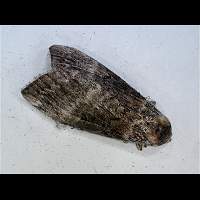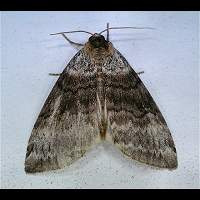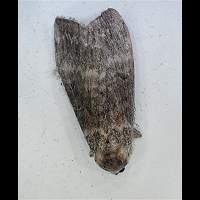Satin Lutestring Tetheella fluctuosa
The Satin Lutestring is a very dull, greyish moth. On the middle of the wings we see a very broad, darker band, often bordered by both a blackish and a whitish indented or wavy line. Above and below these lines the wings are lighter. In the dark band, just near the edge the Satin Lutestring has a dark smear or small blackish, often moon shaped marking. In the very similar Common Lutestring this marking consists of two dark and clearly separated dots. The Satin Lutestring is however extremely variable. The markings may be invisible in melanistic forms or very bright specimens. Usually the lines and other markings are rather vague, sometimes animals appear with very detailed and distinct markings. The wingspan doesn't vary very much, for it is usually between 35 and 39mm.
The eggs are being laid in summer. After hatching, the small caterpillars spin two leaves together and hide in this house during the day. At night they leave their shelter to feed on the leaves around them. In October they'll make a cocoon attached to a few leaves in which pupation takes place. And it is the pupa overwintering. In late autumn the pupa in the cocoon falls to the ground with the leaves. The caterpillars of the Satin Lutestring are dark green with light dots. A whitish mottled line runs over the side of the body, just below the spiracula. The head is yellowish brown with small black markings. The foodplant is birch. Every now and then a caterpillar is found on Alder. They'll reach a length of some 30mm.
In Britain the Satin Lutestring is single-brooded and on the wing from June to early August. On the wing at night only, but comes to light freely. It is a very local species, but maybe numerous where it occurs. Found in Southeast England, Northern and Western Wales and the Lake District. Rare in Scotland, very scarce in Ireland and on the Channel Islands. Widespread, but very local in other parts of Europe too.
The Satin Lutestring is a very dull, greyish moth. On the middle of the wings we see a very broad, darker band, often bordered by both a blackish and a whitish indented or wavy line. Above and below these lines the wings are lighter. In the dark band, just near the edge the Satin Lutestring has a dark smear or small blackish, often moon shaped marking. In the very similar Common Lutestring this marking consists of two dark and clearly separated dots. The Satin Lutestring is however extremely variable. The markings may be invisible in melanistic forms or very bright specimens. Usually the lines and other markings are rather vague, sometimes animals appear with very detailed and distinct markings. The wingspan doesn't vary very much, for it is usually between 35 and 39mm.
The eggs are being laid in summer. After hatching, the small caterpillars spin two leaves together and hide in this house during the day. At night they leave their shelter to feed on the leaves around them. In October they'll make a cocoon attached to a few leaves in which pupation takes place. And it is the pupa overwintering. In late autumn the pupa in the cocoon falls to the ground with the leaves. The caterpillars of the Satin Lutestring are dark green with light dots. A whitish mottled line runs over the side of the body, just below the spiracula. The head is yellowish brown with small black markings. The foodplant is birch. Every now and then a caterpillar is found on Alder. They'll reach a length of some 30mm.
In Britain the Satin Lutestring is single-brooded and on the wing from June to early August. On the wing at night only, but comes to light freely. It is a very local species, but maybe numerous where it occurs. Found in Southeast England, Northern and Western Wales and the Lake District. Rare in Scotland, very scarce in Ireland and on the Channel Islands. Widespread, but very local in other parts of Europe too.






